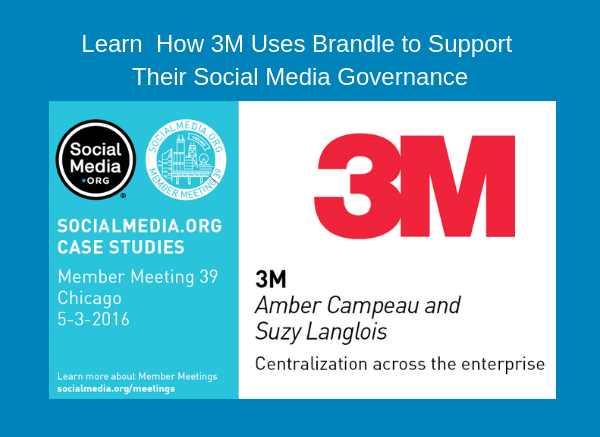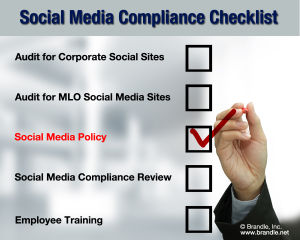 Taming Your Enterprise Social Media Presence
Taming Your Enterprise Social Media Presence
Your boss has just asked you to inventory all the social media accounts used across the enterprise. On the surface, enterprise social media account management may sound simple to your boss but you know it's nothing but.... That's because social media points-of-presence (POPs) can be created by anyone at any time without any form of control or oversight by you or your team.
In most organizations, social media use initially grew organically, without centralized coordination. Many brands are now taking a more strategic approach - but the use (and in some cases, misuse) of social media by employees, partners and imposters increasingly outpaces efforts to manage and monitor.
Knowing where your company and its brands, products and people are being represented is important to any business. However, the task of identifying it all is neither small nor ever complete. If your enterprise is of any size, it can be like putting Humpty Dumpty back together again as you track down hundreds (if not thousands) of accounts, pages, channels, boards, groups, etc!
So what makes for a good enterprise social media account management practice?
At a minimum your audit should include:- Discovery – Which accounts, pages, channels, boards, etc. (i.e. points-of-presence or POPs) appear to be associated with or represent our business?
- Assessment – Which POPs do we want to keep and which do we want to shut down?
- Inventory – Where do we keep track of these POPs now that we've found them?
- Team – Who is responsible for those POPs? Who created them and/or who currently manages them?
- Access & Control – Who has the credentials to each POP and what happens when that person leaves the company?
- Compliance – Are our POPs compliant to brand, corporate or regulatory standards?
- Securing the Tool Chain – What tools are currently being used to manage the content at each POP?
Let's look at each step of the presence audit:
Discovery
The key challenge here is: how do you find all of the POPs employees, partners, vendors, etc. – past and present – have created to represent your business? Discovery is the first step of your social media audit. We've seen companies hire outside auditors, staff up their own teams to search the web and/or "make the rounds," while others have tried to use social media listening systems – only to come up short. The first challenge is that any enterprise has a diverse set of identities that may represent their various business activities (e.g. brands, products, campaigns, people, divisions, etc). The second is that people are not as precise or complete as we would like, which makes the challenge even harder. The third is sometimes the constraints of a platform make it necessary to use a different or non-standard name, description, avatar (e.g. the preferred username is taken or won't fit within the platform's limitations)?
The problem of social presence discovery is huge and using manual searches or listening to the content streams to find everything that is important to the enterprise is just not going to work. You need to use an automated system that can understand your enterprise to exhaustively probe the social web on your behalf to find the relevant points-of-presence.
Assessment
The next step is to triage what the system has found. When the Brandle™ Presence Manager performs an automated discovery for an enterprise, it is not uncommon for it to have examined tens of thousands if not a hundred thousand POPs or more. How long would it take for a team to find and manually review all of those POPs?
That's why you need a system that can learn about your enterprise and like a CSI technician match the fingerprint of each social media point-of-presence to a set of corporate identity profiles. A smart system not only will be able to filter the needles from the haystack but it will also get smarter about your enterprise as you use it.
Inventory
Now that you've exhaustively searched the web and triaged the results, what do you do with all of those relevant POPs you found? The "state of the art" so far has been to store them in a spreadsheet on someone's computer or on a corporate share-point. However, a spreadsheet isn't connected to the web so it will quickly go out of date as new POPs are created, others deleted, and the rest edited. That's why you need a system that will keep up with the dynamic nature of your social presence – we call this a "living inventory." As your presence outside the enterprise changes, your inventory should be updated to reflect those changes.
Team
Once you know where your enterprise is being represented, the next question to answer is "who is managing all this stuff?" If you don't know who's managing what, I'm going to let you in on a little secret: you are not alone. Many companies lack a system for tracking these relationships for multiple reasons. First, social media often grew from the edges of the organization inward and the folks at headquarters are just now trying to create that central repository of knowledge. Second, people come and go but the points-of-presence they create remain. Finally, the social platforms themselves don't make it easy to find out who created or currently maintains a POP. However, for any organization to effectively manage a vast and distributed social presence, it needs not only to be able to identify who is managing what but to communicate and coordinate with those individuals and teams.
The creation of your corporate presence was probably crowd-sourced so why not use the same techniques to identify your social team and associate them with their POPs? Any tool you use to track and protect your social presence should make it easy to communicate with your various stakeholders and allow them to contribute valuable pieces of information to your collective brand presence knowledge base.
Access & Control
OK, you know where your enterprise is being represented and who's associated with which point-of-presence but how do you ensure control of those corporate assets stays with the enterprise? I can tell you story after story of companies being locked out of a branded asset on a social media platform because of employee turnover. The headache and cost of trying to regain control of those lost points-of-presence can be non-trivial. We have even heard of companies in some industries locking their competitors out of key points-of-presence when they convince a person, team or office to switch affiliations!
So, ensuring that control of a point-of-presence remains with the enterprise is an area where an ounce of prevention is worth a pound (or two) of cure. Storing credential information in a spreadsheet which can be copied and shared easily is not a practice that we recommend; neither is storing the passwords to each and every account that represents your enterprise in a single system in the cloud. Your IT teams have already invested heavily in researching, selecting and deploying industry-leading systems for storing and retrieving sensitive information behind the corporate firewall. Why not take advantage of that?
At Brandle, we see no need to reinvent the wheel. However, what you do need is the ability to identify who has the credentials, to whom and when they have been shared, as well as a safe and secure conduit to transfer that sensitive information between parties. This way members of your team can share and store the credentials per your own rules and still have traceability and accountability through your brand presence management system. This also gives you the option to partition (i.e. compartmentalize) the storage of these credentials as necessary so only those who need access have access.
Compliance
Compliance can mean one of three things: brand compliance (does the POP meet brand standards), corporate compliance (does the POP adhere to corporate policies and procedures) and regulatory compliance (does the POP comply with industry rules and regulations). Every point-of-presence on the web has an identity that associates it with your enterprise, rightly or wrongly. This includes brand names, logos, color schemes, and other descriptors. Each customer touch point (i.e. POP) not only needs to reflect the standards of the enterprise but for regulated businesses also to contain the proper disclaimers, disclosures, and avoid unsubstantiated claims.
A good presence management system should allow you to surveil your corporate footprint as well as the POPs of those who are representing your business in the field. A presence management system should not replace a good content management system but it can provide a foundational layer to ensure your content compliance system is configured to cover the breadth and depth of your social presence. All it takes is one rogue and non-compliant POP to open to door to additional compliance headaches.
Securing the Tool Chain
The last pilar of a good presence management system is understanding your tools ecosystem. Most enterprises employ a collection of tools to manage social content. Which tools get used by whom may vary by region, language, division, or agency used. This is all compounded by the growth of cloud tools and mobile applications. When passwords are not easily and tightly controlled, it is possible for anyone with the right credentials to attach an unauthorized platform to one of your POPs. While this may be convenient for an individual employee, each tool and device creates a new vector for an account (or worse) to be compromised.
So, while various teams may employ different systems to meet their business objectives, a good presence management system should offer the possibility of surveilling the whole of your social inventory and report on the tools which are in use. Hackers just need to find a weak link but you need to ensure the whole chain is protected.
Summary
Mature organizations are taking a systematic approach to social presence management. Following these seven steps will ensure your enterprise develops a social presence management approach that is accurate, organized, integrated with your existing business systems, and helps develop a thriving, authentic and valuable social media ecosystem.
Special thanks to Bill Johnston of Autodesk for his contributions to this article. Mr. Johnston is also a member of the Brandle Advisory Board.








